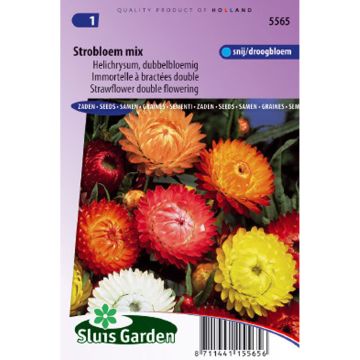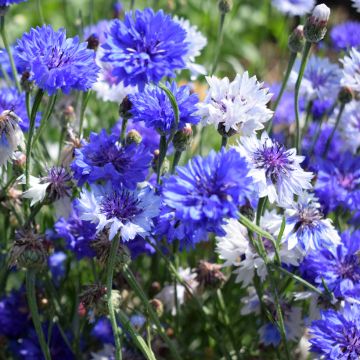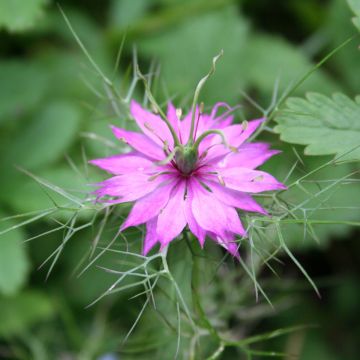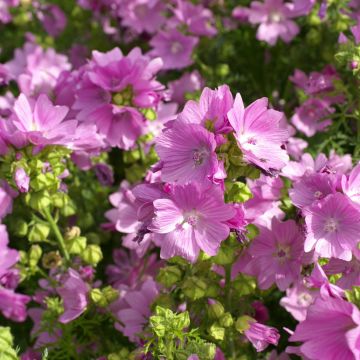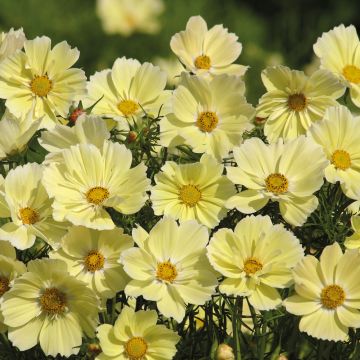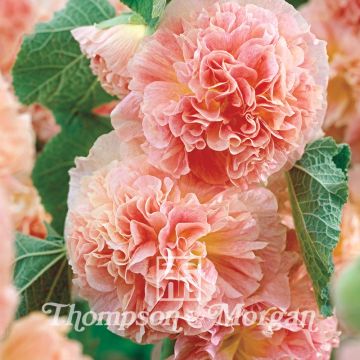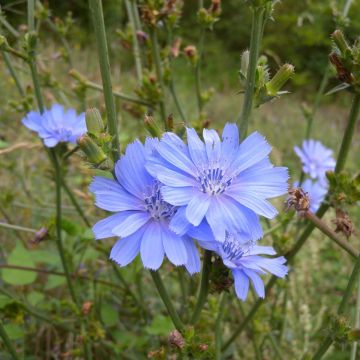

Helianthemum Mixture - Rock Rose
Helianthemum Mixture - Rock Rose
Helianthemum Mix
Rock Rose
Why not try an alternative variety in stock?
View all →This plant carries a 6 months recovery warranty
More information
We guarantee the quality of our plants for a full growing cycle, and will replace at our expense any plant that fails to recover under normal climatic and planting conditions.
Seed-only orders are dispatched by sealed envelope. The delivery charge for seed-only orders is €3.90.
Does this plant fit my garden?
Set up your Plantfit profile →
Description
With their small cistus-like appearance, the Helianthemums of this mix bear adorable rose, lemon, copper, red, purple, and white flowers from May to July, depending on the plants. These evergreen undershrubs are very floriferous and form delightful ground covers. Their evergreen foliage, ranging from green to grey-green-silver, provides a beautiful backdrop to their flowering. They thrive in sunny borders and rockeries, cascading over a low wall or between the stones of a pathway.
Belonging to the Cistaceae family, the helianthemums in this lovely collection come from two botanical species, Helianthemum apenninum, native to southern Europe, and H. mummularium, widespread in Europe and Turkey. Like their ancestors, they love calcareous, rocky, and sandy soils, as well as full sun. Without these conditions, they do not flower and will wither. Helianthemum forms a low, spreading, cushion-like, dense undershrub, 25cm (10in) tall and 30 to 35cm (12 to 14in) wide. Its foliage is evergreen to semi-evergreen, depending on the climate. It is composed of small linear leaves that differ in appearance depending on the plants in the mix we offer. Their colour ranges from dark green to silver-grey. It highlights an abundant and bright flowering in various colours, either solid or bicoloured. From May to August, it is covered with a multitude of small cup-shaped flowers, 3cm (1in) in diameter, with five crumpled petals adorned with a bouquet of golden stamens.
Helianthemum is the ideal plant to enhance a rocky garden, a sunny embankment, in the stones of a pathway, or cascading over a wall. It also looks stunning at the front of perennial beds or raised flower beds. It is suitable for cultivation in pots or containers on patios. It can be used to create green walls and green roofs. It can be associated with other rockery plants (erigeron, shrubby potentilla, shrubby wallflower), as well as perennial plants such as lavender, Iris germanica, cistus, helenium, Convolvulus cneorum and C. sabatius, coreopsis, creeping thyme, and rosemary. Its flowers blend delicately with the grey foliage of stachys, dwarf artemisia, and silver basket (cineraria).
Report an error about the product description
Flowering
Foliage
Plant habit
Botanical data
Helianthemum
Mix
Cistaceae
Rock Rose
Cultivar or hybrid
Other Flower seeds A to Z
Planting and care
Sow the helianthemum seeds from March to June.
Sow the seeds in trays, pots, etc. in moist but well-drained special sowing compost. Barely cover the seeds with compost. Enclose the sown seeds in a transparent plastic bag and keep in a warm place to maintain an optimal temperature of 21 to 24°C (69.8 to 75.2°F). Germination can take 15 to 20 days.
Transplant the young plants once they are large enough to handle, into 8cm (3in) pots. Let them grow under a cold frame and plant them outdoors in full sun, spacing them 30 to 45cm (12 to 18in) apart.
Cultivation:
Helianthemum enjoys being planted in full sun, in neutral or limestone, well-drained soil, even dry in summer, that is rich in gravel or sand. It does not tolerate stagnant moisture in winter. In cold and humid climates, lighten the soil during planting by adding gravel and sand to improve drainage. Helianthemum is a very hardy plant that can withstand temperatures between -15 to -20°C (5 to -4°F). It tolerates drought well and only requires regular and moderate watering during its first year after planting; afterwards, the plant can manage on its own. At the end of flowering, pinch off the faded flower spikes and foliage to encourage autumn regrowth. Lightly prune the clump with hedge shears after flowering to maintain a dense vegetation and prevent the centre from becoming bare. When young, make sure to protect it from weeds that retain moisture and shield it from harsh sunlight.
Sowing period
Intended location
This item has not been reviewed yet - be the first to leave a review about it.
Flower seeds
Haven't found what you were looking for?
Hardiness is the lowest winter temperature a plant can endure without suffering serious damage or even dying. However, hardiness is affected by location (a sheltered area, such as a patio), protection (winter cover) and soil type (hardiness is improved by well-drained soil).

Photo Sharing Terms & Conditions
In order to encourage gardeners to interact and share their experiences, Promesse de fleurs offers various media enabling content to be uploaded onto its Site - in particular via the ‘Photo sharing’ module.
The User agrees to refrain from:
- Posting any content that is illegal, prejudicial, insulting, racist, inciteful to hatred, revisionist, contrary to public decency, that infringes on privacy or on the privacy rights of third parties, in particular the publicity rights of persons and goods, intellectual property rights, or the right to privacy.
- Submitting content on behalf of a third party;
- Impersonate the identity of a third party and/or publish any personal information about a third party;
In general, the User undertakes to refrain from any unethical behaviour.
All Content (in particular text, comments, files, images, photos, videos, creative works, etc.), which may be subject to property or intellectual property rights, image or other private rights, shall remain the property of the User, subject to the limited rights granted by the terms of the licence granted by Promesse de fleurs as stated below. Users are at liberty to publish or not to publish such Content on the Site, notably via the ‘Photo Sharing’ facility, and accept that this Content shall be made public and freely accessible, notably on the Internet.
Users further acknowledge, undertake to have ,and guarantee that they hold all necessary rights and permissions to publish such material on the Site, in particular with regard to the legislation in force pertaining to any privacy, property, intellectual property, image, or contractual rights, or rights of any other nature. By publishing such Content on the Site, Users acknowledge accepting full liability as publishers of the Content within the meaning of the law, and grant Promesse de fleurs, free of charge, an inclusive, worldwide licence for the said Content for the entire duration of its publication, including all reproduction, representation, up/downloading, displaying, performing, transmission, and storage rights.
Users also grant permission for their name to be linked to the Content and accept that this link may not always be made available.
By engaging in posting material, Users consent to their Content becoming automatically accessible on the Internet, in particular on other sites and/or blogs and/or web pages of the Promesse de fleurs site, including in particular social pages and the Promesse de fleurs catalogue.
Users may secure the removal of entrusted content free of charge by issuing a simple request via our contact form.
The flowering period indicated on our website applies to countries and regions located in USDA zone 8 (France, the United Kingdom, Ireland, the Netherlands, etc.)
It will vary according to where you live:
- In zones 9 to 10 (Italy, Spain, Greece, etc.), flowering will occur about 2 to 4 weeks earlier.
- In zones 6 to 7 (Germany, Poland, Slovenia, and lower mountainous regions), flowering will be delayed by 2 to 3 weeks.
- In zone 5 (Central Europe, Scandinavia), blooming will be delayed by 3 to 5 weeks.
In temperate climates, pruning of spring-flowering shrubs (forsythia, spireas, etc.) should be done just after flowering.
Pruning of summer-flowering shrubs (Indian Lilac, Perovskia, etc.) can be done in winter or spring.
In cold regions as well as with frost-sensitive plants, avoid pruning too early when severe frosts may still occur.
The planting period indicated on our website applies to countries and regions located in USDA zone 8 (France, United Kingdom, Ireland, Netherlands).
It will vary according to where you live:
- In Mediterranean zones (Marseille, Madrid, Milan, etc.), autumn and winter are the best planting periods.
- In continental zones (Strasbourg, Munich, Vienna, etc.), delay planting by 2 to 3 weeks in spring and bring it forward by 2 to 4 weeks in autumn.
- In mountainous regions (the Alps, Pyrenees, Carpathians, etc.), it is best to plant in late spring (May-June) or late summer (August-September).
The harvesting period indicated on our website applies to countries and regions in USDA zone 8 (France, England, Ireland, the Netherlands).
In colder areas (Scandinavia, Poland, Austria...) fruit and vegetable harvests are likely to be delayed by 3-4 weeks.
In warmer areas (Italy, Spain, Greece, etc.), harvesting will probably take place earlier, depending on weather conditions.
The sowing periods indicated on our website apply to countries and regions within USDA Zone 8 (France, UK, Ireland, Netherlands).
In colder areas (Scandinavia, Poland, Austria...), delay any outdoor sowing by 3-4 weeks, or sow under glass.
In warmer climes (Italy, Spain, Greece, etc.), bring outdoor sowing forward by a few weeks.









































